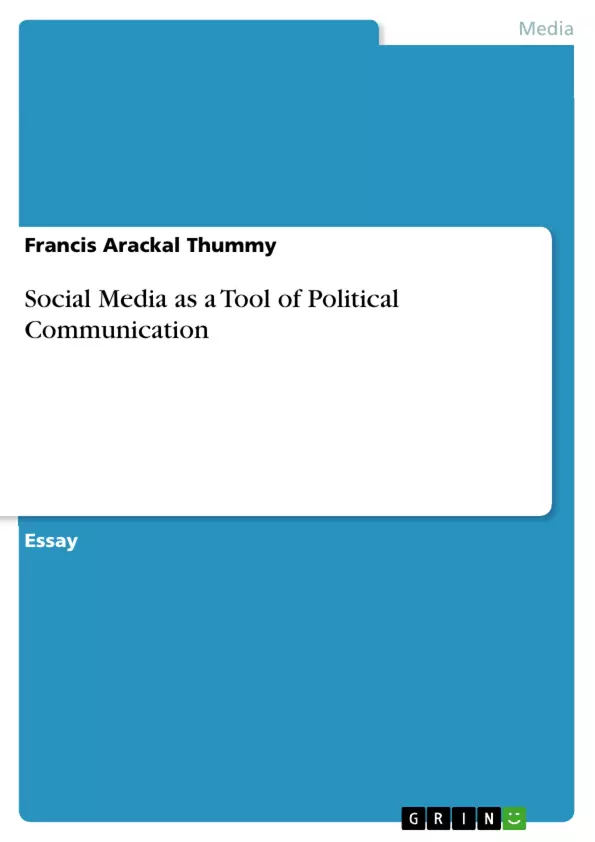Since the US elections in 2008 the close connection between Social Media and political communication has been brought to the fore. The effective role that Social Media has been made to play once again in the 2012 US elections and its conscious or unconscious replication in the 2014 Indian elections reaffirmed its significance in contemporary political communication. Scholars have confirmed that political candidates are increasingly turning to Social Network Sites (SNS) to persuade voters and that these sites have become prominent sources of political information. Political Communication as a field of study has been about the role of communication in the political process. This paper would like to focus entirely on Social Media as a tool in the political process. Political communication has its beginnings during and between the World Wars. There are various types of political communication and political media. Among the political media the Social Media seems to be the most widely used in contemporary political process. The three main elements of political communication are: ideology, propaganda and persuasion. The deployment of Social Media in putting forth one’s or party’s ideology, propagating one’s or party’s agenda, and persuading the voter is widespread as never before. Many scholars including Walter Lippmann doubted the efficacy of media in public enlightenment that democracy requires. For, they thought that media cannot tell the truth objectively. Harold Lasswell too took note of the tendency of media propaganda to dupe and degrade the voters. His work expressed the fear of propaganda. This view was partly based on the direct effects theories of media. Similar fear about the Social Media is lurking in the minds of many today. To camouflage such fear political spin doctors might employ political Public Relations. Political spin doctors are press agents or publicists employed to promote favourable interpretations to journalists. They also weave reports of factual events into palatable stories. The case for political public relations is that it enables paternalism, pluralism, and pragmatism. But there is also a case against it in that it leads to news management and spin, corporatism in politics, and ‘enlightened self-interest’. The increasing availability of internet even in remote parts of the world has made Social Media a virtual public sphere enabling e-democracy.
Table of Contents
- Introduction
- Politics and Communication
- Origin and History of Political Communication
- Theoretical Framework
- Public Sphere
- Agenda Setting
- Methodology
- Types of Political Communication
- Elements of Political Communication
- Ideology
- Propaganda
- Persuasion
- Political Public Relations
- Political Advertising and Marketing
- Political Spin doctoring
- Origin and growth of social media
- Impact of Social Media
- Social Media and Political Campaigning
- Social Media and Political Advertising
- Social Media and Political Public Relations
- Social Media and Political Agenda Setting
- Social Media as the New Political Public Sphere
Objectives and Key Themes
This paper examines the role of social media as a tool of political communication, focusing on how social media has transformed contemporary political processes. It explores the impact of social media on political campaigning, advertising, public relations, agenda setting, and the creation of a new public sphere.
- Social Media as a Tool of Political Communication
- The Evolution of Political Communication in the Digital Age
- The Influence of Social Media on Political Campaigns and Elections
- The Role of Social Media in Shaping Public Opinion and Political Discourse
- The Challenges and Opportunities of Social Media in a Democratic Society
Chapter Summaries
The paper begins by defining key concepts such as politics, communication, and political communication. It traces the historical development of political communication, highlighting the evolution of media and its impact on political discourse. The paper then delves into the theoretical framework underpinning its analysis, focusing on Habermas's concept of the public sphere and the agenda-setting theory. The paper explores various types and elements of political communication, including ideology, propaganda, and persuasion. It examines the role of political public relations and advertising in shaping public perception. Lastly, the paper analyzes the emergence and influence of social media in contemporary political processes, examining its impact on political campaigning, public relations, agenda setting, and the formation of a new public sphere.
Keywords
The primary focus of this paper lies on the intersection of social media and political communication. It explores the impact of social media on various aspects of political processes, including campaigning, advertising, public relations, agenda setting, and the formation of a new public sphere. Key concepts addressed in this study include political communication, public sphere, agenda setting, ideology, propaganda, persuasion, political public relations, and social media.
- Quote paper
- Prof. Francis Arackal Thummy (Author), 2015, Social Media as a Tool of Political Communication, Munich, GRIN Verlag, https://www.grin.com/document/513240



